Fairy Circles | Namibia | Australia | Grass | Desert
Fairy Circles – Information about the Mystery
Fairy circles are round, bare patches in the dry grassland that are characterized by an extremely ordered distribution in the landscape. Most fairy circles in Namibia have diameters of 4-8 m, but they can be up to more than 20 m in diameter. They exist along the Namib Desert from northern South Africa to southern Angola and have been discovered by us also in Australia. In the following I will give you a short overview of my research on fairy circles, which resulted in 17 publications on this topic. This overview covers all the steps that finally led me and my colleagues to the conclusion that fairy circles are a self-organized vegetation pattern resulting from plant competition for water and associated biomass-water feedbacks. All my research activities are based on co-operation with various partners from Namibia, South Africa, Israel, Australia and the United States.
First research activities in the year 2000
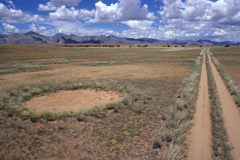 I first saw the fairy circles in 1999 when I was traveling with a communal conservation project in north-western Namibia. There we visited the nomadic Himba people in the Marienfluss Valley who live in the middle of the fairy circles. The local Himba don't pay much attention to these circular holes in the grass, but as an ecology student I was immediately fascinated. A year later, a first expedition to the fairy circles of the Giribes Plains, the Marienfluss Valley and the Hartmann’s Valley followed. When we explored the fairy circles in early 2000 in the north-west of Namibia, nearly nothing was known about these mysterious circles. No extensive data basis existed by that time and just very few hypotheses about the origin of fairy circles were mentioned in either Afrikaans language (Theron 1979, Eicker et al. 1982) or in a conference proceeding (Moll 1994). Without such knowledge it was tricky to test specific questions with our study Becker & Getzin 2000, published in the journal Basic and Applied Ecology. As a side effect, with this publication we introduced the name “fairy circles” for the first time in the scientific literature, because fairy circles are circular vegetation gaps and not plant rings. More than 20 years later, we have written a historical overview of fairy circles and defined how they differ from other common vegetation gaps and plant rings. The German name for fairy circles is Feenkreise. The two competing hypotheses that existed until that time in the year 2000 were 1) the allelopathic interaction between poisonous Euphorbia damarana plants and grass vegetation where the decomposed Euphorbia remains are thought to kill the grass (Theron 1979) and 2) harvester termites of the species Hodotermes mossambicus are clipping grass and cause a circular bare-soil patch (Moll 1994).
I first saw the fairy circles in 1999 when I was traveling with a communal conservation project in north-western Namibia. There we visited the nomadic Himba people in the Marienfluss Valley who live in the middle of the fairy circles. The local Himba don't pay much attention to these circular holes in the grass, but as an ecology student I was immediately fascinated. A year later, a first expedition to the fairy circles of the Giribes Plains, the Marienfluss Valley and the Hartmann’s Valley followed. When we explored the fairy circles in early 2000 in the north-west of Namibia, nearly nothing was known about these mysterious circles. No extensive data basis existed by that time and just very few hypotheses about the origin of fairy circles were mentioned in either Afrikaans language (Theron 1979, Eicker et al. 1982) or in a conference proceeding (Moll 1994). Without such knowledge it was tricky to test specific questions with our study Becker & Getzin 2000, published in the journal Basic and Applied Ecology. As a side effect, with this publication we introduced the name “fairy circles” for the first time in the scientific literature, because fairy circles are circular vegetation gaps and not plant rings. More than 20 years later, we have written a historical overview of fairy circles and defined how they differ from other common vegetation gaps and plant rings. The German name for fairy circles is Feenkreise. The two competing hypotheses that existed until that time in the year 2000 were 1) the allelopathic interaction between poisonous Euphorbia damarana plants and grass vegetation where the decomposed Euphorbia remains are thought to kill the grass (Theron 1979) and 2) harvester termites of the species Hodotermes mossambicus are clipping grass and cause a circular bare-soil patch (Moll 1994).
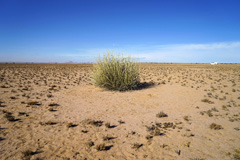 While the Euphorbia hypothesis cannot explain the recurrent formation of new fairy circles in areas that are completely lacking Euphorbia bushes, on our excursion in 2000 we did indeed find harvester termites that were clipping off grass stems and likely caused a vegetation-free patch. We also recorded how heat-tolerant carnivorous Ocymyrmex ants were preying on the harvester termites that suffered from thermal distress at temperatures above 40°C, leading to the hypothesis that this heat sensitivity of the termites and predation by ants could explain the limited size of fairy circles.
While the Euphorbia hypothesis cannot explain the recurrent formation of new fairy circles in areas that are completely lacking Euphorbia bushes, on our excursion in 2000 we did indeed find harvester termites that were clipping off grass stems and likely caused a vegetation-free patch. We also recorded how heat-tolerant carnivorous Ocymyrmex ants were preying on the harvester termites that suffered from thermal distress at temperatures above 40°C, leading to the hypothesis that this heat sensitivity of the termites and predation by ants could explain the limited size of fairy circles.
A new, holistic research approach
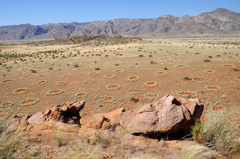 However, these early observations and hypotheses in support of the termite theory have one crucial shortcoming – that is the field recordings were done on a very local scale of evaluating potential processes just for the individual fairy circle. But later work has demonstrated that many fairy circles in Namibia show no sign of termite activity. Also, these arid grasslands along the Namib Desert are largely lacking ecological resistance, hence multiple disturbing agents can disrupt the grass layer and a bare-soil patch may form. More than ten years later and having previously unavailable new data and methods accessible, it was time to reconsider that any valid hypothesis about the origin of fairy circles must be able to explain also the detailed characteristics of the spatial patterning at small scales and large landscape scales, as well as the fact that fairy circles do only occur within a very narrow climatic envelope. That is, the core area of their occurrence is found between 70-120 mm mean annual precipitation, which is only a very narrow strip of a few dozen kilometers from west to east along the Pro-Namib. One research discipline that made tremendous progress in the first ten years of the new Millennium is called Spatial Ecology where plant and animal distributions are precisely analyzed with spatial statistics and null models that correspond to null hypotheses or put simply, to ecological questions. These methods which are primarily based on point-pattern analyses allow spatially-explicit hypothesis testing for adequate pattern-process inference.
However, these early observations and hypotheses in support of the termite theory have one crucial shortcoming – that is the field recordings were done on a very local scale of evaluating potential processes just for the individual fairy circle. But later work has demonstrated that many fairy circles in Namibia show no sign of termite activity. Also, these arid grasslands along the Namib Desert are largely lacking ecological resistance, hence multiple disturbing agents can disrupt the grass layer and a bare-soil patch may form. More than ten years later and having previously unavailable new data and methods accessible, it was time to reconsider that any valid hypothesis about the origin of fairy circles must be able to explain also the detailed characteristics of the spatial patterning at small scales and large landscape scales, as well as the fact that fairy circles do only occur within a very narrow climatic envelope. That is, the core area of their occurrence is found between 70-120 mm mean annual precipitation, which is only a very narrow strip of a few dozen kilometers from west to east along the Pro-Namib. One research discipline that made tremendous progress in the first ten years of the new Millennium is called Spatial Ecology where plant and animal distributions are precisely analyzed with spatial statistics and null models that correspond to null hypotheses or put simply, to ecological questions. These methods which are primarily based on point-pattern analyses allow spatially-explicit hypothesis testing for adequate pattern-process inference.
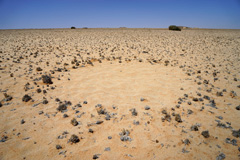 That means at first the “spatial fingerprint” of the inherent structure of a pattern has to be identified and then the question is which known process is most likely – or on the contrary unlikely – to cause that particular pattern. The change of pattern characteristics with scale from a few meters to a few hundred meters and beyond is thereby of central interest. During my Ph.D. between 2003 and 2007 when I specialized into this still quite novel type of hypothesis testing, these methods became more and more powerful and sophisticated due to better computers and more precise and extensive spatial data based either on high-resolution aerial imagery or modern GPS recordings.
That means at first the “spatial fingerprint” of the inherent structure of a pattern has to be identified and then the question is which known process is most likely – or on the contrary unlikely – to cause that particular pattern. The change of pattern characteristics with scale from a few meters to a few hundred meters and beyond is thereby of central interest. During my Ph.D. between 2003 and 2007 when I specialized into this still quite novel type of hypothesis testing, these methods became more and more powerful and sophisticated due to better computers and more precise and extensive spatial data based either on high-resolution aerial imagery or modern GPS recordings.
Vegetation self-organization as a new explanation
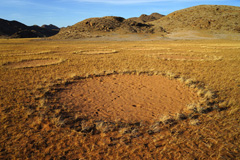 In 2009, after a visit of the fairy circles in the Kunene, I acquired aerial imagery of fairy circles from the Marienfluss Valley and the Giribes Plains. During that time fairy circle research was still relatively “inactive” when compared with the tremendously busy research efforts nowadays. After the year 2000, only five more articles on the topic “fairy circles” appeared in the Web of Science until 2011, with on average one new paper being published every second or third year. In 2012 and 2013, each year two articles appeared and since 2015 we do have a real “boom” with up to ten or even more new papers appearing every single year. Meanwhile, three main hypotheses crystallized between 2011 and 2015: that is 1) the hypothesis on toxic, abiotic gas-leakage from deep-lying underground reservoirs that would cause plant death where gas “chimneys” reach the soil surface, 2) the well-known insect hypothesis that was added with new observations or correlations on ants and sand termites as potential causal agent, and 3) the vegetation self-organization hypothesis claiming that fairy circles are natural patterns that appear just by plant competition for the scarce soil water.
In 2009, after a visit of the fairy circles in the Kunene, I acquired aerial imagery of fairy circles from the Marienfluss Valley and the Giribes Plains. During that time fairy circle research was still relatively “inactive” when compared with the tremendously busy research efforts nowadays. After the year 2000, only five more articles on the topic “fairy circles” appeared in the Web of Science until 2011, with on average one new paper being published every second or third year. In 2012 and 2013, each year two articles appeared and since 2015 we do have a real “boom” with up to ten or even more new papers appearing every single year. Meanwhile, three main hypotheses crystallized between 2011 and 2015: that is 1) the hypothesis on toxic, abiotic gas-leakage from deep-lying underground reservoirs that would cause plant death where gas “chimneys” reach the soil surface, 2) the well-known insect hypothesis that was added with new observations or correlations on ants and sand termites as potential causal agent, and 3) the vegetation self-organization hypothesis claiming that fairy circles are natural patterns that appear just by plant competition for the scarce soil water.
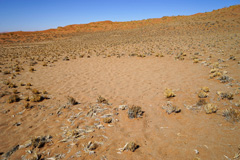 The latter hypothesis argues that the vegetation-gap pattern, hence the bare soil of the circles, is an expression of water shortage along the Pro-Namib because there is not enough rainfall to sustain a continuous layer with grass vegetation. The so-called pattern-formation theory from physics predicts that in that case, strongly ordered gap patterns will emerge. Based on the purchased aerial images from 2009 and spatially-explicit analyses of the fairy-circle distributions, we evaluated these three main hypotheses on the origin of fairy circles in an article that was published in May 2014 in Ecography. We searched through all available publications on gas and termite distribution patterns in drylands and found that there is no evidence that would show the ability of these two agents to cause the extremely ordered and at the same time large-scale homogeneously distributed pattern that is such a unique characteristic of the fairy circles.
The latter hypothesis argues that the vegetation-gap pattern, hence the bare soil of the circles, is an expression of water shortage along the Pro-Namib because there is not enough rainfall to sustain a continuous layer with grass vegetation. The so-called pattern-formation theory from physics predicts that in that case, strongly ordered gap patterns will emerge. Based on the purchased aerial images from 2009 and spatially-explicit analyses of the fairy-circle distributions, we evaluated these three main hypotheses on the origin of fairy circles in an article that was published in May 2014 in Ecography. We searched through all available publications on gas and termite distribution patterns in drylands and found that there is no evidence that would show the ability of these two agents to cause the extremely ordered and at the same time large-scale homogeneously distributed pattern that is such a unique characteristic of the fairy circles.
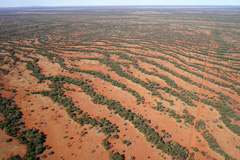 Instead, we support the hypothesis of vegetation self-organization because not only our process-based model was able to reproduce the exceptional ordering of fairy circles but also all knowledge on plant self-organization does support this hypothesis. We are following a new line of thinking where it is appreciated that plants may be a lot more “intelligent” (in the widest sense) than was previously thought. Notably, the general theory about vegetation-pattern formation along a moisture gradient such as the growth of spots, stripes or gaps is relatively novel in ecological science because this theory was mainly rooted in physics and mathematics and thus it was published in journals that are usually not red by ecologists.
Instead, we support the hypothesis of vegetation self-organization because not only our process-based model was able to reproduce the exceptional ordering of fairy circles but also all knowledge on plant self-organization does support this hypothesis. We are following a new line of thinking where it is appreciated that plants may be a lot more “intelligent” (in the widest sense) than was previously thought. Notably, the general theory about vegetation-pattern formation along a moisture gradient such as the growth of spots, stripes or gaps is relatively novel in ecological science because this theory was mainly rooted in physics and mathematics and thus it was published in journals that are usually not red by ecologists.
CNN: Nature’s greatest mystery?
In 2014, CNN referred to our work in the article Namibia’s ‘fairy circles’: Nature’s greatest mystery? The controversy illustrates that science is a process, not a definitive set of facts, as has been well-formulated in the article What fairy circles teach us about science. In February 2015, the 1st Fairy Circle Symposium took place at Wolwedans where various active fairy circle researchers met to discuss the different hypotheses. In 2015, we also published a new article in Ecological Entomology which was again in support of the vegetation self-organization hypothesis and which explained in detail the pattern characteristics for small and large scales. Our main conclusions on spatial patterns were also supported in a large meta-analysis in which we compared the typical distribution of fairy circles with the typical patterns of many social insects worldwide. We again found that none of the termite or ant nesting patterns found in water-limited drylands have the ability to cause the extremely regular, so-called spatially periodic pattern that is so characteristic of fairy circles. Thus, the behavior of termites or their colonies in drylands cannot explain the distribution of fairy circles, as these social insects are obviously unable to produce similarly ordered patterns. However, we have not only focused our research on the typical fairy circles in Namibia, but have also tried to learn from atypical fairy circles in Namibia and new fairy circle patterns that we have found in Western Australia.
Discovery of fairy circles in Australia
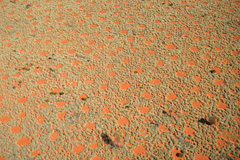 Our explanation of fairy circles as a universal expression of self-organized plant patterns got considerable momentum when I received in 2014 an e-mail with an aerial image of an apparently similar phenomenon being found 10,000 km away from Namibia in the remote outback of Western Australia. Up to that time genuine fairy circles, which are defined by their exceptionally rare, spatially periodic pattern, were unknown from any other place except the Namib Desert. Soon, spatial analysis of those “new” fairy circles verified that the Australian gap pattern must be indeed true fairy circles and not just common, less ordered insect-induced gap patterns that are often known from elsewhere in Australia and from other parts of world. In December 2014 we flew to Newman in the remote Australian outback and investigated those fairy circles for the first time.
Our explanation of fairy circles as a universal expression of self-organized plant patterns got considerable momentum when I received in 2014 an e-mail with an aerial image of an apparently similar phenomenon being found 10,000 km away from Namibia in the remote outback of Western Australia. Up to that time genuine fairy circles, which are defined by their exceptionally rare, spatially periodic pattern, were unknown from any other place except the Namib Desert. Soon, spatial analysis of those “new” fairy circles verified that the Australian gap pattern must be indeed true fairy circles and not just common, less ordered insect-induced gap patterns that are often known from elsewhere in Australia and from other parts of world. In December 2014 we flew to Newman in the remote Australian outback and investigated those fairy circles for the first time.
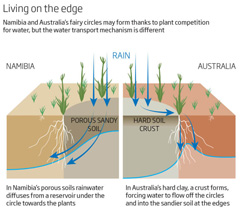 It turned out that these Australian fairy circles are even in stronger support for the self-organization hypothesis because at one and the same place the grasses there may form circular gaps and stripe-like patterns in response to water stress. In contrast, termites as primary causal agent could be excluded after digging at typical fairy circles sites.
These study results were published in March 2016 in the journal Proceedings of the National Academy of Sciences. In short, we postulated in this article that identical spatial patterns may globally emerge if they are triggered by the same type of natural instability. The gaps in Namibia and Australia both function as an important extra source of water for the surrounding grass vegetation in this arid environment which was well illustrated in a graph published in New Scientist. Other reports followed in the BBC or The New York Times and they testify to the general interest in unresolved nature puzzles.
It turned out that these Australian fairy circles are even in stronger support for the self-organization hypothesis because at one and the same place the grasses there may form circular gaps and stripe-like patterns in response to water stress. In contrast, termites as primary causal agent could be excluded after digging at typical fairy circles sites.
These study results were published in March 2016 in the journal Proceedings of the National Academy of Sciences. In short, we postulated in this article that identical spatial patterns may globally emerge if they are triggered by the same type of natural instability. The gaps in Namibia and Australia both function as an important extra source of water for the surrounding grass vegetation in this arid environment which was well illustrated in a graph published in New Scientist. Other reports followed in the BBC or The New York Times and they testify to the general interest in unresolved nature puzzles.
 From 2017, I conducted a three-year research project on the Australian fairy circles in close collaboration with colleagues from the University of Western Australia. I brought about 80 kg drone equipment, including a laser scanner and a multi-spectral camera to the small town of Newman in Western Australia, as well as a fully autonomously working weather station to measure soil moisture, soil temperature, humidity and more. During these years, we examined the formation of the Australian fairy circles in detail. We excavated them in an extensive survey, showing that not termite pavements were responsible for the absence of vegetation within the gaps but the weathering-induced clay crusts form the fairy circles. Our soil moisture data also show that the clay crusts formed quickly after intensive rain events within the fairy circle, because the particle dispersion on the sand surface in combination with the surface temperature of up to more than 70°C causes the topsoil to “bake”. We could show that the Triodia grasses act as ecosystem engineers which form more and more closed barriers after destructive fire. Thereby they utilize the runoff water from the fairy circles in the most optimal way. Finally, we could also demonstrate with spatially-explicit analysis of grass vitality that the Triodia grasses show scale-dependent biomass-water feedbacks, agreeing with typical Turing mechanisms that induce also other periodic patterns in completely different environments. These fairy circles occur only within a very small area east and southeast of Newman but they are a prime example of vegetation self-organization in harsh and water-limited environments. Our recent Nature article from 2024 summarizes the key findings of our work, explaining that Australian fairy circles are caused by mechanisms of abiotic weathering and associated biomass-water feedbacks. It is therefore another self-organized vegetation pattern such as tree stripes and labyrinths, which are typically created by runoff-erosion and extreme heat in many parts of the Australian outback.
From 2017, I conducted a three-year research project on the Australian fairy circles in close collaboration with colleagues from the University of Western Australia. I brought about 80 kg drone equipment, including a laser scanner and a multi-spectral camera to the small town of Newman in Western Australia, as well as a fully autonomously working weather station to measure soil moisture, soil temperature, humidity and more. During these years, we examined the formation of the Australian fairy circles in detail. We excavated them in an extensive survey, showing that not termite pavements were responsible for the absence of vegetation within the gaps but the weathering-induced clay crusts form the fairy circles. Our soil moisture data also show that the clay crusts formed quickly after intensive rain events within the fairy circle, because the particle dispersion on the sand surface in combination with the surface temperature of up to more than 70°C causes the topsoil to “bake”. We could show that the Triodia grasses act as ecosystem engineers which form more and more closed barriers after destructive fire. Thereby they utilize the runoff water from the fairy circles in the most optimal way. Finally, we could also demonstrate with spatially-explicit analysis of grass vitality that the Triodia grasses show scale-dependent biomass-water feedbacks, agreeing with typical Turing mechanisms that induce also other periodic patterns in completely different environments. These fairy circles occur only within a very small area east and southeast of Newman but they are a prime example of vegetation self-organization in harsh and water-limited environments. Our recent Nature article from 2024 summarizes the key findings of our work, explaining that Australian fairy circles are caused by mechanisms of abiotic weathering and associated biomass-water feedbacks. It is therefore another self-organized vegetation pattern such as tree stripes and labyrinths, which are typically created by runoff-erosion and extreme heat in many parts of the Australian outback.
Plant water stress, not termite herbivory, causes Namibia’s fairy circles
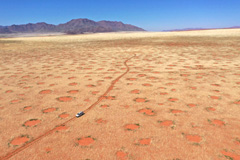 During the rainy seasons 2020 to 2022, we conducted very intense research on Namibia’s fairy circles, which was funded by the German Research Foundation. We also used that time for testing the Euphorbia hypothesis because we were able to find the fairy circles and decaying shrubs that Theron marked in the late 1970s. Examining these shrubs four decades later, we had to reject the Euphorbia hypothesis because none of the shrubs formed a fairy circle over that long time. Moreover, grass growth was not hampered under decaying shrubs and also there was not a single Euphorbia pattern that showed a spatially periodic pattern as, for example, the fairy circles in the Giribes Plains where also Euphorbias exist. But this project was more about examining in detail how the young green grasses died in fairy circles. Every year we drove about 10,000 km up and down the Namib, always in search for recent rainfall events that triggered the growth of new grasses within and around fairy circles.
With our new publication Plant water stress, not termite herbivory, causes Namibia’s fairy circles we summarize the results of this fieldwork. For the first time, we have systematically excavated 500 grasses at four regions of the Namib to investigate the temporal process of how the young grasses die in fairy circles. The dying grasses within fairy circles had significantly larger root-to-shoot ratios than the vital grasses in the matrix. This is a strong indication that the grasses died from water stress because the desiccating grasses invested biomass resources into roots to reach the deeper soil layers with more moisture, but they failed.
During the rainy seasons 2020 to 2022, we conducted very intense research on Namibia’s fairy circles, which was funded by the German Research Foundation. We also used that time for testing the Euphorbia hypothesis because we were able to find the fairy circles and decaying shrubs that Theron marked in the late 1970s. Examining these shrubs four decades later, we had to reject the Euphorbia hypothesis because none of the shrubs formed a fairy circle over that long time. Moreover, grass growth was not hampered under decaying shrubs and also there was not a single Euphorbia pattern that showed a spatially periodic pattern as, for example, the fairy circles in the Giribes Plains where also Euphorbias exist. But this project was more about examining in detail how the young green grasses died in fairy circles. Every year we drove about 10,000 km up and down the Namib, always in search for recent rainfall events that triggered the growth of new grasses within and around fairy circles.
With our new publication Plant water stress, not termite herbivory, causes Namibia’s fairy circles we summarize the results of this fieldwork. For the first time, we have systematically excavated 500 grasses at four regions of the Namib to investigate the temporal process of how the young grasses die in fairy circles. The dying grasses within fairy circles had significantly larger root-to-shoot ratios than the vital grasses in the matrix. This is a strong indication that the grasses died from water stress because the desiccating grasses invested biomass resources into roots to reach the deeper soil layers with more moisture, but they failed.
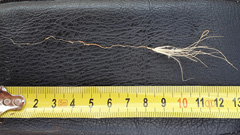 The freshly germinated green grasses with their on average 10 cm long roots die quickly after rainfall due to lack of water, because these small plants cannot reach and utilize the higher soil moisture, which is only found in deeper soil layers. The top 10 cm of soil within the fairy circles is very susceptible to drying out. Hundreds of soil-moisture measurements show that the topsoil is significantly drier within fairy circles as compared to the matrix soils outside. The topsoil is thus a “death zone” where the young green grasses die due to desiccation. Our continuous soil-moisture recordings in and around fairy circles indicate that the vital matrix grasses outside of the circles strongly pulled the soil water from the interior of the fairy circles. This is because soil moisture within the fairy circles dropped only rapidly when surrounding green grasses established after rainfall. But when grasses were not yet established after the very first rainfall events, soil water did not rapidly decline within the fairy circles. The quick death of the germinating grasses inside the fairy circles in several regions of the Namib is thus due to plant water stress and desiccation. The large and competitively superior grasses around the circles thereby actively engineer the vegetation gaps and benefit from these additional water reservoirs via long-distance diffusion of soil water.
The freshly germinated green grasses with their on average 10 cm long roots die quickly after rainfall due to lack of water, because these small plants cannot reach and utilize the higher soil moisture, which is only found in deeper soil layers. The top 10 cm of soil within the fairy circles is very susceptible to drying out. Hundreds of soil-moisture measurements show that the topsoil is significantly drier within fairy circles as compared to the matrix soils outside. The topsoil is thus a “death zone” where the young green grasses die due to desiccation. Our continuous soil-moisture recordings in and around fairy circles indicate that the vital matrix grasses outside of the circles strongly pulled the soil water from the interior of the fairy circles. This is because soil moisture within the fairy circles dropped only rapidly when surrounding green grasses established after rainfall. But when grasses were not yet established after the very first rainfall events, soil water did not rapidly decline within the fairy circles. The quick death of the germinating grasses inside the fairy circles in several regions of the Namib is thus due to plant water stress and desiccation. The large and competitively superior grasses around the circles thereby actively engineer the vegetation gaps and benefit from these additional water reservoirs via long-distance diffusion of soil water.
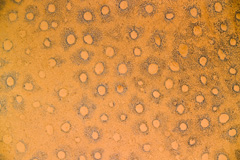 This self-organization of the grasses is supported by the very high water conductivity of the coarse-grained sand of the fairy circles, because at a soil water content above 8% of the soil volume, the soil physical conditions allow the water to be sucked out of the fairy circle. In other words, soil water diffusion and the mobility of water in these Namib sands are very high, if the volumetric moisture content is also high. Our published measurement data from 20 cm depth in the fairy circle show that the soil water content was indeed always very high during the first weeks after four typical rainfall events. From the day of raining until twenty days later, the soil water content ranged between 18% to above 8% in the rainy seasons 2021 and 2022. Thus, purely in terms of soil physics, a very high water conductivity to the outside to the grasses is given, which is further enhanced by the active suction of water via the grass roots and the accompanying concentration gradient in soil moisture. In particular, the perennial, rapidly greening large grasses around the periphery of the fairy circles suck up water strongly because of their enormous competitive advantage.
This self-organization of the grasses is supported by the very high water conductivity of the coarse-grained sand of the fairy circles, because at a soil water content above 8% of the soil volume, the soil physical conditions allow the water to be sucked out of the fairy circle. In other words, soil water diffusion and the mobility of water in these Namib sands are very high, if the volumetric moisture content is also high. Our published measurement data from 20 cm depth in the fairy circle show that the soil water content was indeed always very high during the first weeks after four typical rainfall events. From the day of raining until twenty days later, the soil water content ranged between 18% to above 8% in the rainy seasons 2021 and 2022. Thus, purely in terms of soil physics, a very high water conductivity to the outside to the grasses is given, which is further enhanced by the active suction of water via the grass roots and the accompanying concentration gradient in soil moisture. In particular, the perennial, rapidly greening large grasses around the periphery of the fairy circles suck up water strongly because of their enormous competitive advantage.
 This causes rapid drying of the uppermost soil layer after ten to twenty days, where the young grasses die with their 10 cm long roots in the fairy circle. The fact that fairy circles store a large amount of water for a long time in lower soil layers below 30 cm, and in particular below 50 cm to 100 cm depth, is irrelevant for the rapidly dying seedlings in the upper 10 cm of soil. This is due to the fact that it is mainly the highly competitive grasses around the edge of the circles that benefit from this deep water source over meters, as also grass halos with distinct gradients of biomass around fairy circles show. The grasses arrange themselves in a round shape, because of all geometric shapes, a circle has the smallest circumference-to-area ratio. Thus, each individual plant on the fairy circle perimeter benefits maximally from the water source from greater depths.
This causes rapid drying of the uppermost soil layer after ten to twenty days, where the young grasses die with their 10 cm long roots in the fairy circle. The fact that fairy circles store a large amount of water for a long time in lower soil layers below 30 cm, and in particular below 50 cm to 100 cm depth, is irrelevant for the rapidly dying seedlings in the upper 10 cm of soil. This is due to the fact that it is mainly the highly competitive grasses around the edge of the circles that benefit from this deep water source over meters, as also grass halos with distinct gradients of biomass around fairy circles show. The grasses arrange themselves in a round shape, because of all geometric shapes, a circle has the smallest circumference-to-area ratio. Thus, each individual plant on the fairy circle perimeter benefits maximally from the water source from greater depths.
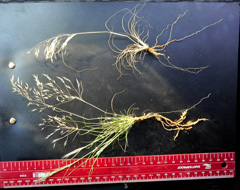 Our data published in PPEES also show that the dying grasses inside the fairy circles had even longer roots than the vital grasses outside, because they invested their biomass resources in trying to reach soil water from deeper layers. At Brandberg, the median root length of the dead grasses in the fairy circle was with 12.5 cm significantly longer than the 9.8 cm long roots of the green vital grasses outside of the fairy circle. Our many image comparisons and video documentations of plant roots of dead and vital grasses also demonstrate that root herbivory by termites was not present because the wilting grasses inside the fairy circles were completely undamaged when they initially died. Hence, termite herbivory can neither explain the death of the grasses, nor could such biomass consumption explain why the dying grasses inside the circles had even significantly longer roots than the green and vital grasses outside in the surrounding matrix. In our new study we emphasize that “no termite individuals or nests were found under or nearby the excavated grasses”. Several fairy circle researchers stated in The New York Times that “the new study showed ‘conclusively’ that termites were not a factor” and that “termite activity does not cause the fairy circles”. In Solving the fairy circle mystery using scientific evidence, published by Conservation Namibia and the Namibian Chamber of Environment in April 2023, the difference between a correlation between fairy circles and sand termites or Euphorbias and actual causation is also well explained.
Our data published in PPEES also show that the dying grasses inside the fairy circles had even longer roots than the vital grasses outside, because they invested their biomass resources in trying to reach soil water from deeper layers. At Brandberg, the median root length of the dead grasses in the fairy circle was with 12.5 cm significantly longer than the 9.8 cm long roots of the green vital grasses outside of the fairy circle. Our many image comparisons and video documentations of plant roots of dead and vital grasses also demonstrate that root herbivory by termites was not present because the wilting grasses inside the fairy circles were completely undamaged when they initially died. Hence, termite herbivory can neither explain the death of the grasses, nor could such biomass consumption explain why the dying grasses inside the circles had even significantly longer roots than the green and vital grasses outside in the surrounding matrix. In our new study we emphasize that “no termite individuals or nests were found under or nearby the excavated grasses”. Several fairy circle researchers stated in The New York Times that “the new study showed ‘conclusively’ that termites were not a factor” and that “termite activity does not cause the fairy circles”. In Solving the fairy circle mystery using scientific evidence, published by Conservation Namibia and the Namibian Chamber of Environment in April 2023, the difference between a correlation between fairy circles and sand termites or Euphorbias and actual causation is also well explained.
In times of climate change and prolonged droughts, researchers are increasingly interested in studying the ability of plants to self-organize and redistribute scarce resources like water, as also a recent media release by The Washington Post has highlighted. In this endeavor, the fairy circles are a shining example and may inspire further research on this topic in the future.
Welcome to FAIRY-CIRCLES.info! I am interested in the ecology of drylands, fairy circles, plant rings and all kinds of spatial vegetation and animal patterns, using a whole range of quantitative methods.
